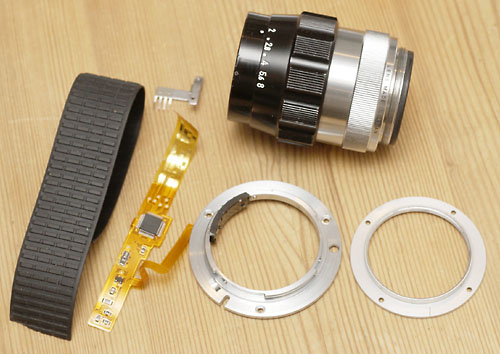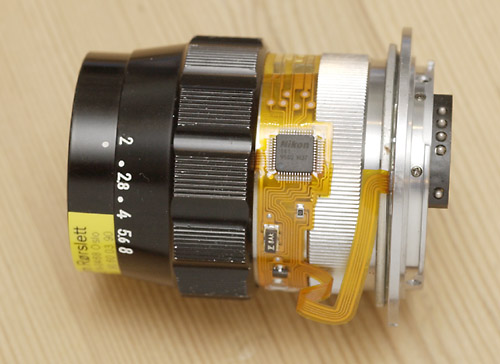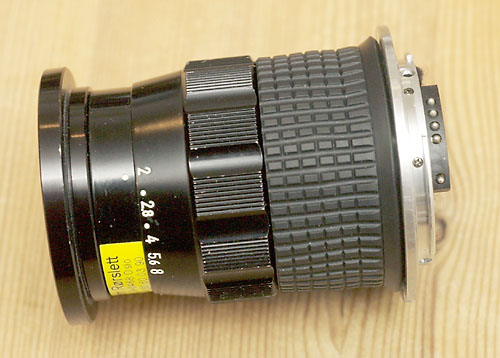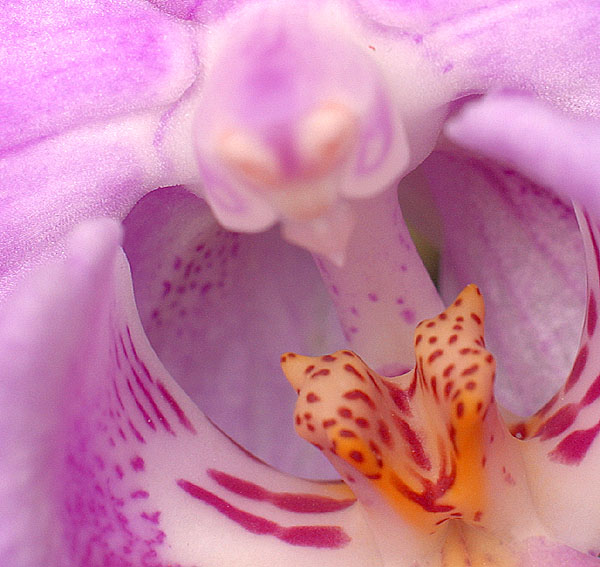Oldies But Goodies:
Rejuvenating an Ultra-Micro-Nikkor lens
by
Bjørn Rørslett |
|
| |
|
High quality
optics of bygone days still can produce stunning images. If
modern cameras can be tricked into metering with them, that is.
Read on to learn more.
Ever now and then I come
across remarkable or interesting items. My Ultra-Micro-Nikkor
lenses belong to this category. They were designed for industrial
applications, for example in silicon wafer production. Optimised
for narrow spectral ranges and fixed magnifications, the
Ultra-Micro-Nikkors were top performers of their period and many
of them perform close to the theoretical possible limits set by
diffraction.
Why would anybody be foolish
enough to use such old rarities, in a world bursting with all the
latest optical innovations? Well, for my close-up photography
these old lenses have certain desirable features all of their
own. They can deliver outstandingly sharp images at wider
apertures than any conventional Micro-Nikkor lens, thus throwing
the background entirely out of focus. The non-focused background
takes on a exceedingly soft, veiled and nearly shimmering
quality, utterly unlike that of modern, highly corrected lenses.
Because of their quite short focal lengths in conjunction with
high speed, it often is possible for me to do hand-held close-up
photography, something I normally cannot do.
However, even when I manage to
coax such odd lenses into being mounted on my Nikons, using a
plethora of lens adapters, metering remains a big issue. Athough
my D1-series cameras will meter with such contraptions, only
centre-weighted and spot metering modes are available.
Centre-weighted metering is frequently very inaccurate with these
lenses and spot metering often impractical, so getting matrix
metering available is a big benefit. Of course, for a D100 user
the question simply is to get metering at all with manual lenses.
Enter the matrix chips from modern AF Nikkors. Thanks to the
easiness by which modern consumer plastic zoom lenses
self-destruct, and the fact that the people of my Nikon repair
facility are really nice guys, I'm ensured of a plentiful supply
of all those neat chips. The Nikon guys even provide free metal
lens mounts on their most joyous days. Nice of them and good on
me.
This article describes the
project of converting an Ultra-Micro-Nikkor 55 mm f/2 lens, which
I purchased very cheap from a German second-hand store many years
ago. The 55 mm lens does not fully illuminate a 24 x 36 mm frame,
but will cover the smaller digital frame of my D1-series Nikons.
It has the advantage of not requiring to be reversed, unlike my
28 mm f/1.8 Ultra-Micro-Nikkor. With a working magnification
around 1:3 it is perfect for flower close-ups. I initially opted
for chip-modifying a CRT-Nikkor 55 mm f/1.2 (Oscilloscope lens),
but the extremely large rear element of that lens and its
Leica-thread mount made it impossible to fit a chip to it. So, I
soldiered on with the 55 mm f/2 Ultra-Micro-Nikkor instead.

© Bjørn Rørslett/NN
|
| Modifying an
Ultra-Micro-Nikkor 55 mm f/2 lens to give it full matrix
metering capability The bits and pieces needed for
conversion are as follows,
rubber sheathing (from
the focusing collar of a wrecked AF Nikkor lens), CPU
print (from a crashed AF 28-80 Nikkor) attached to a
metal "F" lens mount (from a damaged AF 35-70
Nikkor), and a spare Leica 39 mm thread mount (from my
odds-and-ends bin).The 4-fingered sliding contact is used
for setting the "wide-open" aperture to any
convenient value. The chip and print is a "D"
type, however, as the increased print size was
impractical in the context of the project, I simply cut
away the "D" segment, after having tested that
the chip continued to relay the aperture data to the
camera.
And of course, there
is the Ultra-Micro-Nikkor lens itself. In case you didn't
know, it has an old-fashioned Leica mount.
(defect Nikkors were scavenged
from the scrap heap of my Nikon repair facility so came
absolutely free)
|

|
| As depicted above, the Leica and
Nikon lens mounts have been unified so as to allow the
Ultra-Micro lens to be fitted. I just glued the mounts
together using epoxy glue. The lens is screwed home and
secured with a small set screw run through the rear
bayonet. The contact board chafes into the Leica mount so
a slight trimming is needed. A small metal file
judiciously applied to the threads does the trick. The CPU print has been provisionally laid
out on the outside of the lens barrel. There simply is no
way a print can be tucked away inside this particular
lens. Putting the print on the outside makes it
vulnerable, hence additional protective measures are
needed (see later). I also locked the nominal aperture
permanently (at f/3.5 as it were), this is just a value
and doesn't mean anything as long as stop-down metering
is employed. The camera merely displays the f-number
reported to it by the CPU chip, and sets exposure
according to the light levels recorded by its meter. Only
if external light meters are consulted this discrepancy
emerges, but if you prefer hand-held meters you are
unlikely to embark on a matrix chip upgrade anyway).
(In answer to why f/3.5 was
chosen: well, this combination of aperture and zoom lens
setting from the print chip results in a unique EXIF
identifier, so I , or rather my software, can tell the
Ultra 55 has been used. Just for my statistics
department, no real importance can be attached to this
figure, but still fun)
|

|
| Here is the end result of the
conversion. The original inconvenient 40.5 mm filter size
has been expanded to 52 mm by a set of step-up rings.
This allows for attaching filters and standard Nikon lens
caps. The rubber collar is
the final touch, combining protection of the delicate
chip circuitry with a better grip for mounting and
detaching the lens.
(Mk.II shown here, slightly better
fitting rubber collar)
|
The Ultra-Micro-Nikkor lens
obviously was not designed for general photography. The need to
have the SLR mirror clearing the rear end of the lens entails far
too much lens extension as well, so lens performance is reduced
even further. It reportedly is optimised for 1:4 magnification.
Notwithstanding these potential issues, the lens projects images
with biting sharpness at nearly all aperture settings. Just see
for yourself (below).
 |
Tyger,
tyger, burning bright
in
the forests of the night,
what
immortal hand or eye
could
frame thy fearful symmetry?
William Blake (1757-1827)
Photography
© Bjørn Rørslett/NN 2002
|
Nikon D1X
with Ultra-Micro-Nikkor 55 mm f/2 lens, shot at f/2.8
The literal
'bite' and crispness of the image rendition really set
the Ultra-Micro-Nikkor apart from other lenses. Who cares
about lens age when such results can be attained?
|
| Oldies But Goodies:
Rejuvenating an Ultra-Micro-Nikkor lens |
|
| |



